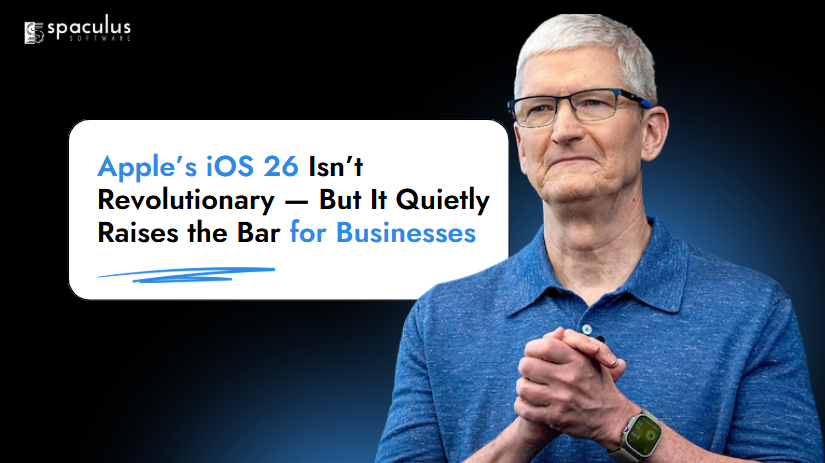
Apple announced iOS 26 last week.
Most headlines focused on “Liquid Glass.”
Some called it the biggest redesign in years.
But if you’ve been in tech long enough, you already know the truth:
This isn’t a revolution.
It’s a reframing.
No dramatic leap. No breakthrough AI.
Just enough change to force businesses to catch up.
And that’s exactly why it matters.
“Liquid Glass” — the new visual aesthetic — is just that: a visual.
It looks good. It feels clean.
It mimics depth and translucency.
But under the hood?
Nothing has fundamentally changed in how the system works.
So why should you care?
Because Apple has quietly retrained users to expect:
If your app, site, or service still feels like it was designed in 2021 —
It’s going to stand out.
And not in a good way.
Apple redesigned a few key elements — lock screen, app icons, camera UI.
They cleaned up the interface.
They flattened the noise.
It’s nothing groundbreaking — but it’s a problem if your product isn’t evolving at the same pace.
| Element | iOS 25 (Before) | iOS 26 (Now) |
| App Icons | Flat, static shapes | Glass-like, translucent icons |
| Lock/Home Screens | Bordered, segmented | Full bleed, edge-to-edge content |
| Safari & Camera UI | Functional, generic | Minimalist, more gesture-driven |
If you ignore this shift, your brand will feel behind — even if your tech is solid.
The AI everyone expected? Barely there.
Let’s talk about the so-called “Apple Intelligence.”
You’d expect more, especially after how aggressively Google, Microsoft, and OpenAI have moved in the last 12 months.
Instead, we got:
All useful.
But all playing catch-up.
Apple didn’t lead here — they followed, quietly.
And in doing so, they’ve made one thing clear:
They’re betting on small, embedded AI — not giant language models in the cloud.
If you’re building AI features and your entire strategy depends on server-side GPT prompts, you’re missing what comes next.
| Company | What They’re Doing | What It Actually Means |
| Gemini + AI-first redesigns | Feature-rich, but overloaded | |
| Microsoft | Copilot in every workflow | B2B edge, less mobile-native |
| Apple | Visual tools + on-device models | Subtle, efficient, slower rollout |
No major leap. No AI keynote moment.
Just quiet feature nudges inside everyday workflows.
That’s not hype.
It’s strategy.
One of the better features in iOS 26 is Call Screening.
Unknown number?
Your iPhone now asks the caller to state who they are and why they’re calling — before you decide to pick up.
Combined with Hold Assist and Live Translation, this changes how people interact with businesses over the phone.
But let’s not act like it’s innovation.
Google Pixel had similar features years ago.
This is Apple catching up — not leading.
Group typing indicators.
Built-in polls.
Custom message backgrounds.
These sound like filler features.
But they point to something bigger:
Apple is turning Messages into a lightweight collaboration platform — without saying it.
It’s not Slack. It’s not Discord.
But it’s a quiet nudge in that direction.
If you’re building anything around communication, team coordination, or communities —
Start watching iMessage more closely.
These are good quality-of-life updates.
But don’t mistake them for “innovation.”
They’re about removing friction, not adding power.
And that’s a lesson every product team should take seriously.
| Apple Update | Product Insight You Can Use |
| Custom snooze controls | Users want control over small decisions |
| Dirty lens alerts | User content quality matters |
| CarPlay widgets | Visibility during mobility = attention |
These aren’t “wow” features.
They’re smart, invisible optimizations.
Your product needs more of those.
Not on the surface.
But under the surface — yes.
Because Apple’s entire update is a reminder:
Users don’t need new features.
They need fewer steps, better focus, and interfaces that don’t slow them down.
That’s what iOS 26 actually delivers.
Not flash. Not hype.
Just tighter execution.
And now, that’s the new expectation.
iOS 26 is not exciting.
And that’s exactly why you should pay attention.
Because the next wave of growth won’t come from shiny new tech.
It’ll come from quiet improvements done well —
By businesses that know how to adapt before they have to.
Don’t wait until your product feels clunky.
Fix it now, while most of your competitors are still pretending this update was “just a design change.”